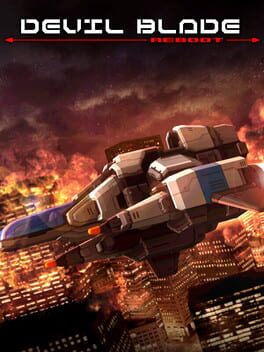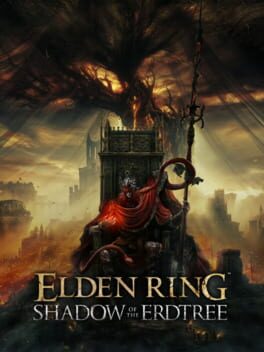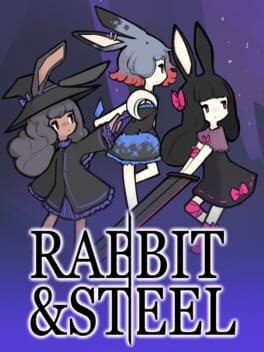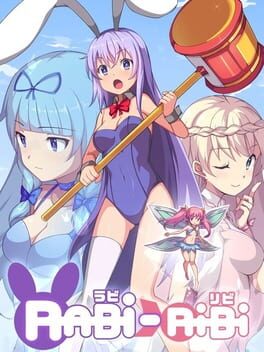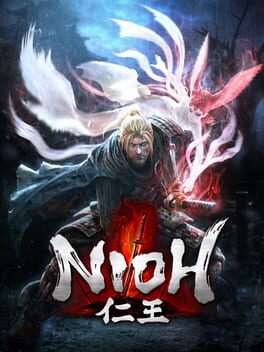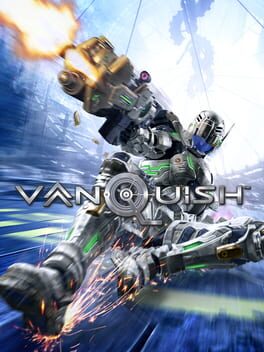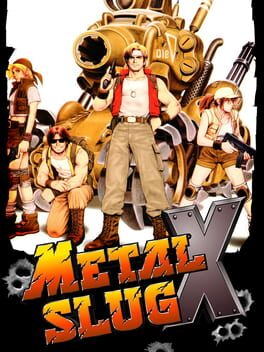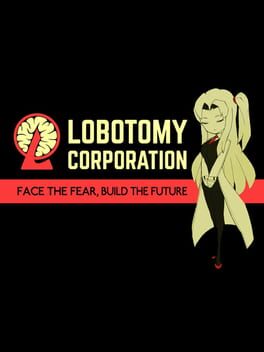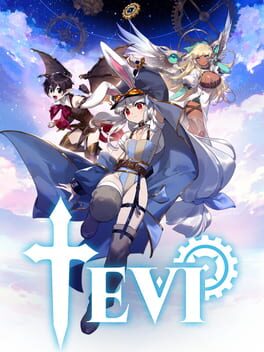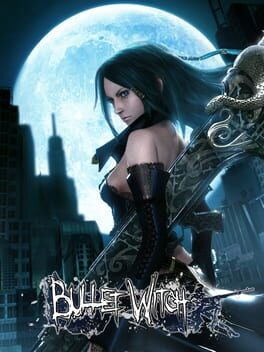39 reviews liked by AiriBan
Devil Blade Reboot
2024
Devil Blade Reboot really is every bit as good as you've likely heard it is. I love the Treasure game design energy on display here. An elegant display of shmup genre fundamentals mastered with stages made up of rigid-but-complex enemy formations that become increasingly nuanced the more you push the game's scoring mechanics. The emphasis on telegraphed attacks and occasional enemy attacks coming at you from the back ground gives Devil Blade Reboot a rail shooter kind of vibe that also makes it stand out from the crowd. The telegraphed attacks are frenetic and overlap often enough to still have the same kind of dynamism that traditional shmup bullet patterns have. More games in the genre need to do this and experiment with the kinds of attacks/patterns that enemies, especially bosses can do.
The scoring is based around playing aggressively like a maniac, destroying enemies at as close to point-blank range as possible. This is quite the pastiche scoring mechanic for indie-developed shmups at this point BUT Devil Blade Reboot manages to introduce a simple but much-needed innovation to the playstyle - up-close kills will increase your Berserk meter. When this meter is at 100% or higher the player enters BERSERK MODE, wherein all multipliers are multiplied by 5x and enemies speed up their attacks or even increase the number of attacks in certain cases. This gives the game a cathartic sense of push-and-pull between the player's actions and the game's response that reminds me somewhat of the rank management in Battle Garegga or Crimzon Clover's excellent Boost arrange mode. There's even an Inferno difficulty mode where you must play for score or you die, which is as cool as it is funny to think about as a concept.
There's a wide range within the game's 4 difficulties - easy and normal are pretty friendly to genre newcomers with their generous autobomb/shield mechanics while still keeping all the game's thrills, whereas hard and especially inferno are a big step up, not quite as hard as the arcade games of old but more than enough meat for us shmupheads to chew into. There's even some longevity encouraged for newcomers too, since the game has an unlock menu which will require a lot of playthroughs to collect enough coins to unlock everything.
Shigatake really did not miss when it comes to the presentational aspects of this game, the sprite art and sound design is nice and CHONKY while still having a (mostly) high degree of clarity. The new soundtrack is also great and captures the PSX-era buttrock charm very well.
I was honestly a bit skeptical of the praise this game was getting before trying it for myself, but now Devil Blade Reboot is up there with the likes of Cho Ren Sha 68k or even Crimzon Clover for excellent indie/doujin developed shoot em ups.
The scoring is based around playing aggressively like a maniac, destroying enemies at as close to point-blank range as possible. This is quite the pastiche scoring mechanic for indie-developed shmups at this point BUT Devil Blade Reboot manages to introduce a simple but much-needed innovation to the playstyle - up-close kills will increase your Berserk meter. When this meter is at 100% or higher the player enters BERSERK MODE, wherein all multipliers are multiplied by 5x and enemies speed up their attacks or even increase the number of attacks in certain cases. This gives the game a cathartic sense of push-and-pull between the player's actions and the game's response that reminds me somewhat of the rank management in Battle Garegga or Crimzon Clover's excellent Boost arrange mode. There's even an Inferno difficulty mode where you must play for score or you die, which is as cool as it is funny to think about as a concept.
There's a wide range within the game's 4 difficulties - easy and normal are pretty friendly to genre newcomers with their generous autobomb/shield mechanics while still keeping all the game's thrills, whereas hard and especially inferno are a big step up, not quite as hard as the arcade games of old but more than enough meat for us shmupheads to chew into. There's even some longevity encouraged for newcomers too, since the game has an unlock menu which will require a lot of playthroughs to collect enough coins to unlock everything.
Shigatake really did not miss when it comes to the presentational aspects of this game, the sprite art and sound design is nice and CHONKY while still having a (mostly) high degree of clarity. The new soundtrack is also great and captures the PSX-era buttrock charm very well.
I was honestly a bit skeptical of the praise this game was getting before trying it for myself, but now Devil Blade Reboot is up there with the likes of Cho Ren Sha 68k or even Crimzon Clover for excellent indie/doujin developed shoot em ups.
Gungrave G.O.R.E
2022
Gungrave G.O.R.E: is the literal coolest thing ever
Reviewers: "This fucking sucks actually"
Seriously backloggd, a 2.4 average rating? I know this game had a bunch of balance issues at launch which is when most of the reviews would have been made, but I swear open world slop and copypasted soulslikes have melted gamers' brains to the point where they can't recognise a fun, genuine action game anymore, or possibly what fun even is, because Gungrave is a fuckin' fun game!
Gungrave G.O.R.E is essentially a PS2 shooter with (mostly) modern visuals - the whole midschool package is here: a campaign which takes you from stage to stage, a focus on pure action with absolutely no distractions, RPG mechanics, puzzles and other filler garbage, an over the top anime bullshit story told with charmingly-amateurish voice acting and a clear distinction between in-engine and CG cutscenes, all topped off with a strict performance-grading system to encourage replayability.
The idea of G.O.R.E's gameplay is basically the same as previous entries in this series: you shoot the first thing you see and don't stop shooting until everything is dead and clear the stage. G.O.R.E steps things up with the enemy design and setpieces to encourage constant movement and regular usage of all your abilities to survive and increase your ranking. Missile spamming enemies will pressure your position from a distance with rockets that can either be dodged or deflected with melee attacks. Shielded enemies will contest you at a closer distance and can be destroyed with either melee attacks, demolition shots or activating fury mode. I like this style of enemy design because more prominent enemies have to be prioritised with certain actions, but at the same time it doesn't feel as "simon says" as something like Doom Eternal. Stage environments can blend together somewhat but there are regular setpieces to mix things up such as the train section.
The boss fights are... decent. They feel quite boomer-shooterish in the sense that you can beat all of them by just circlestrafing and shooting at them until they die, but bosses will occasionally do AOE melee attacks and WHOA DUDE BULLET HELL BRO patterns to make you have to move more carefully. Most bosses also have a second phase to make things more exciting. Honestly the stage 1 boss was my favourite due to having destructable parts that made it feel almost like a shmup boss and fitting very nicely with the beat chaining system this game has.
Shooting just about anything, so not just enemies but also environmental scenery will contribute to your beat count which is this game's chaining system. High chain counts are required for getting A or S ranks in stages and having a chain count of 50 or above at any time will allow you to do certain special attacks, so there is both a survival and scoring incentive for shooting everything in combination. This chaining system is where the gameplay of G.O.R.E really comes together, almost all stages are designed so that they can be fully chained through and keeping your chain going between arenas requires some actual tactical routing of your shots and keeping environmental objects around for the right time. When combined with fury mode and demolition shots that can be used to keep your chain going in a pinch, it almost feels like the chaining in Dodopachi Daioujou, just a lot more accessible. Killing enemies in certain ways will also build up your ART score which is separate from the chain, so keeping these two scores in balance adds extra depth.
I will admit that even after the many patches this game has had since its release, there are still some problems. There's no control rebinding of any kind, which while not a dealbreaker is a bit stupid, the execution animations are janky and not nearly as satisfying as the Doom Glory Kills that they're trying to emulate. It's often unclear or outright inconsistent as to which environmental objects can be destroyed and which can't - I lost several chains because I was shooting an object which could be blown up in a previous stage but cannot be destroyed in that stage for some reason. The melee focused character Quartz is just not fun to play at all. While the balance update changes are mostly good, the devs overcorrected in some places, such as removing all but 1 of the QTEs (only having one QTE in the entire game is just... weird), and removing basically all the obstacles in the train stage.
There's something to be said for game length too. While Gungrave G.O.R.E doesn't overstay its welcome, it comes very close to doing so. The game's campaign will take about 8-9 hours to beat on your first playthrough and there are 31 stages in total, some of which can be quite long. This feels like a 5-6 hour game being stretched to 8-9 hours just to appease reviewers who want Hours of Content (who ended up dismissing the game anyway!). While each region has very cool stages, some stages almost feel like duplicates, and overall the game could have been 20 stages with basically no impact on the overall experience and perhaps even an increase in replayability.
So yeah, if surprisingly intricate resource management/scoring systems and shooting loads of bad guys for hours on end sounds like your idea of a good time, give Gungrave G.O.R.E a shot, it's possibly one of the most overlooked action games of the decade so far.
Reviewers: "This fucking sucks actually"
Seriously backloggd, a 2.4 average rating? I know this game had a bunch of balance issues at launch which is when most of the reviews would have been made, but I swear open world slop and copypasted soulslikes have melted gamers' brains to the point where they can't recognise a fun, genuine action game anymore, or possibly what fun even is, because Gungrave is a fuckin' fun game!
Gungrave G.O.R.E is essentially a PS2 shooter with (mostly) modern visuals - the whole midschool package is here: a campaign which takes you from stage to stage, a focus on pure action with absolutely no distractions, RPG mechanics, puzzles and other filler garbage, an over the top anime bullshit story told with charmingly-amateurish voice acting and a clear distinction between in-engine and CG cutscenes, all topped off with a strict performance-grading system to encourage replayability.
The idea of G.O.R.E's gameplay is basically the same as previous entries in this series: you shoot the first thing you see and don't stop shooting until everything is dead and clear the stage. G.O.R.E steps things up with the enemy design and setpieces to encourage constant movement and regular usage of all your abilities to survive and increase your ranking. Missile spamming enemies will pressure your position from a distance with rockets that can either be dodged or deflected with melee attacks. Shielded enemies will contest you at a closer distance and can be destroyed with either melee attacks, demolition shots or activating fury mode. I like this style of enemy design because more prominent enemies have to be prioritised with certain actions, but at the same time it doesn't feel as "simon says" as something like Doom Eternal. Stage environments can blend together somewhat but there are regular setpieces to mix things up such as the train section.
The boss fights are... decent. They feel quite boomer-shooterish in the sense that you can beat all of them by just circlestrafing and shooting at them until they die, but bosses will occasionally do AOE melee attacks and WHOA DUDE BULLET HELL BRO patterns to make you have to move more carefully. Most bosses also have a second phase to make things more exciting. Honestly the stage 1 boss was my favourite due to having destructable parts that made it feel almost like a shmup boss and fitting very nicely with the beat chaining system this game has.
Shooting just about anything, so not just enemies but also environmental scenery will contribute to your beat count which is this game's chaining system. High chain counts are required for getting A or S ranks in stages and having a chain count of 50 or above at any time will allow you to do certain special attacks, so there is both a survival and scoring incentive for shooting everything in combination. This chaining system is where the gameplay of G.O.R.E really comes together, almost all stages are designed so that they can be fully chained through and keeping your chain going between arenas requires some actual tactical routing of your shots and keeping environmental objects around for the right time. When combined with fury mode and demolition shots that can be used to keep your chain going in a pinch, it almost feels like the chaining in Dodopachi Daioujou, just a lot more accessible. Killing enemies in certain ways will also build up your ART score which is separate from the chain, so keeping these two scores in balance adds extra depth.
I will admit that even after the many patches this game has had since its release, there are still some problems. There's no control rebinding of any kind, which while not a dealbreaker is a bit stupid, the execution animations are janky and not nearly as satisfying as the Doom Glory Kills that they're trying to emulate. It's often unclear or outright inconsistent as to which environmental objects can be destroyed and which can't - I lost several chains because I was shooting an object which could be blown up in a previous stage but cannot be destroyed in that stage for some reason. The melee focused character Quartz is just not fun to play at all. While the balance update changes are mostly good, the devs overcorrected in some places, such as removing all but 1 of the QTEs (only having one QTE in the entire game is just... weird), and removing basically all the obstacles in the train stage.
There's something to be said for game length too. While Gungrave G.O.R.E doesn't overstay its welcome, it comes very close to doing so. The game's campaign will take about 8-9 hours to beat on your first playthrough and there are 31 stages in total, some of which can be quite long. This feels like a 5-6 hour game being stretched to 8-9 hours just to appease reviewers who want Hours of Content (who ended up dismissing the game anyway!). While each region has very cool stages, some stages almost feel like duplicates, and overall the game could have been 20 stages with basically no impact on the overall experience and perhaps even an increase in replayability.
So yeah, if surprisingly intricate resource management/scoring systems and shooting loads of bad guys for hours on end sounds like your idea of a good time, give Gungrave G.O.R.E a shot, it's possibly one of the most overlooked action games of the decade so far.
Chaos Wars
2006
So this game is pretty fucking funny…
…for the first two hours, then it turns into a mixture of bland cringe, predictable tropes and nonsensical drivel filled with beloved franchises of the niche degree that you MAY have seen one of those characters from.
This game sucks chat. This early ps2 srpg Disgaea-like had the budget of a 1980s newly moved NYC resident who had dreams of making it big on Broadway without knowing the consequences and tribulations of finding work as a theatre Extra. The funding was so dire that the main localization director for this title had to resort to using his family as voice actors due to their constrained budget! Everyone knows of the infamous vid on YT “ REAL bad voice acting”, but this vid touched on the a small segment on a variety of vastly….unique dialogue that happens throughout Chaos Wars. The video is one of the famous bad cases, but lord, the worst one has to be where they introduced some side character, and his voice actor from the sound alone was most likely an 8 year old reading off a script right after finishing a day at elementary school! There are other cases where the monster dialogue comprises of a psycho screeching into the mic attempting to be a bird. The voice dialogue is special to say the least.
Now the gameplay follows your standard srpg, you have many units to choose from, you can level them up, you can give them equipment and abilities to make them stronger, and you have a shop to purchase new equipment and consumables, it’s the works, ya know. Every srpg has their own gimmick attached to their respective game to make them stand out amongst others. Disgaeas gimmicks change with every entry lol, ff tactics has the Job Point mechanic for unlocking new classes, Devil Survivor 2 with their Skill Cracking, the list goes on and on. Chaos Wars gimmick falls under the Realize mechanic, which is akin to a super mode for every unit. It lackluster and pretty much mandatory after halfway through the game since a majority of your damage comes from the Realize buff alone. Without that buff, you’re dead within one turn unless you super leveled one of your units, and even then, you have a slight chance of living bc everything starting at the middle of the game decides to do more than 60% of your health without top of the line equipment that is rare to come by. And to add on top of that, bosses just happen to have a buttload of HP bc damage numbers inflation or some shit like that.
On a normal fight, enemies range from having around 600-1500hp and deal between 150-600 worth of damage to your allies. Allies range from having around 2k hp with attacks that can take out a quarter to one-shot enemies depending on the setup. A cracked ally (if you have been super leveling them the entire run) can have up to 5k HP and deal around 3k worth of damage under Realize without hard grinding into gear and abilities. Now bosses (keep in mind, normal bosses) around mid-game to late, can have between 30-50k worth of HP and deal one-shot damage to any unmitigated ally who has not been hard buffed from the get-go. Now this sounds formulaic for normal bosses, they tend to have larger stats just bc. I’m going to discuss now why this sucks absolute dick due to Chaos Wars worst feature, and one of the worst features I’ve played through: Auto Percent Recovery Status
Every turn, and I mean EVERY TURN, something heals. If it is an allies turn, they heal by their recovery stat that was outlined in red. The same applies to enemies as well. For instance, if an enemy did 5 damage to a 10 hp ally, they would be at 5/10 hp left, but a segment of that hp lost would be in red. By the allies next turn, they automatically recover a portion of their health BY that red segment, so without any out of turn healing or items, they automatically heal by their next turn, so they would have 7/10 hp by their next turn. This practice fucking sucks as an automatic permanent feature for everyone because this is what makes bosses almost unbeatable without a seriously hard beater. That 30k health bar I mentioned earlier? They recover a great portion of their health from the red segment despite all the damage I do with all my party members combined. The fights takes so much longer thanks to this gimmick; its like adding interest for their health, so instead of fighting a 30k enemy, I’ve done about 250k worth of damage because of the automatic percent healing mechanic. There is a very annoying work around for this, but it requires a lot of healing and Ailment items, which negate their healing factor for 2 turns. My endgame strat came down to preventing their healing factor while healing my own health from the enemies massive damage attack and slowing their turn gauge so they wouldn’t act for 15 turns. Its more complicated than I’m explaining, but I do not want to explain steps 1-50 on how I defeated the 60k level 100 final boss. Absolute dogshit game design.
The plot is nothing to write home about. Its an isekai crossover game about a boy and his friends trying to go home but the forces of evil prevent them from doing so! Its up to him and the friends he made along the way to stop evil and return home! Oh and the translations fucked lmao. So the script is decent at least, I say that bc goddamn the writers for this game were passionate fans of each entry that was in Chaos Wars. There was segments talking about detailed moments from each game that I was genuinely surprised was even mentioned in some crossover game. Now the translators on the other hand, is a different matter entirely. They translated one of my favorite characters in fiction Yuri Hyuga into Uru. They translated his power of Harmonixer and Fusion into Tengaio. Chat what the FUCK is a Tengaio!! The translation is noticeably done by a beginner with a deadline of three weeks to translate the entire game lmao. Typos are apparent, abilities and effects are pretty much made up in some scenarios, ex. Final Boss has an ability that nullifies all physical effects, yet I was able to both Paralyze and Ail him at separate moments, I had no weapon nor any ability that nullified this case, all of these were inflicted by throwable items.
This game did not have to be as long as it intended to be, the amount of save states I needed to make due to game overs leading to title screens made me tear my hair out. I played this game so you wouldn’t have to, and in case if you ever get curious to try it out on your own: x2 speed everything.
…for the first two hours, then it turns into a mixture of bland cringe, predictable tropes and nonsensical drivel filled with beloved franchises of the niche degree that you MAY have seen one of those characters from.
This game sucks chat. This early ps2 srpg Disgaea-like had the budget of a 1980s newly moved NYC resident who had dreams of making it big on Broadway without knowing the consequences and tribulations of finding work as a theatre Extra. The funding was so dire that the main localization director for this title had to resort to using his family as voice actors due to their constrained budget! Everyone knows of the infamous vid on YT “ REAL bad voice acting”, but this vid touched on the a small segment on a variety of vastly….unique dialogue that happens throughout Chaos Wars. The video is one of the famous bad cases, but lord, the worst one has to be where they introduced some side character, and his voice actor from the sound alone was most likely an 8 year old reading off a script right after finishing a day at elementary school! There are other cases where the monster dialogue comprises of a psycho screeching into the mic attempting to be a bird. The voice dialogue is special to say the least.
Now the gameplay follows your standard srpg, you have many units to choose from, you can level them up, you can give them equipment and abilities to make them stronger, and you have a shop to purchase new equipment and consumables, it’s the works, ya know. Every srpg has their own gimmick attached to their respective game to make them stand out amongst others. Disgaeas gimmicks change with every entry lol, ff tactics has the Job Point mechanic for unlocking new classes, Devil Survivor 2 with their Skill Cracking, the list goes on and on. Chaos Wars gimmick falls under the Realize mechanic, which is akin to a super mode for every unit. It lackluster and pretty much mandatory after halfway through the game since a majority of your damage comes from the Realize buff alone. Without that buff, you’re dead within one turn unless you super leveled one of your units, and even then, you have a slight chance of living bc everything starting at the middle of the game decides to do more than 60% of your health without top of the line equipment that is rare to come by. And to add on top of that, bosses just happen to have a buttload of HP bc damage numbers inflation or some shit like that.
On a normal fight, enemies range from having around 600-1500hp and deal between 150-600 worth of damage to your allies. Allies range from having around 2k hp with attacks that can take out a quarter to one-shot enemies depending on the setup. A cracked ally (if you have been super leveling them the entire run) can have up to 5k HP and deal around 3k worth of damage under Realize without hard grinding into gear and abilities. Now bosses (keep in mind, normal bosses) around mid-game to late, can have between 30-50k worth of HP and deal one-shot damage to any unmitigated ally who has not been hard buffed from the get-go. Now this sounds formulaic for normal bosses, they tend to have larger stats just bc. I’m going to discuss now why this sucks absolute dick due to Chaos Wars worst feature, and one of the worst features I’ve played through: Auto Percent Recovery Status
Every turn, and I mean EVERY TURN, something heals. If it is an allies turn, they heal by their recovery stat that was outlined in red. The same applies to enemies as well. For instance, if an enemy did 5 damage to a 10 hp ally, they would be at 5/10 hp left, but a segment of that hp lost would be in red. By the allies next turn, they automatically recover a portion of their health BY that red segment, so without any out of turn healing or items, they automatically heal by their next turn, so they would have 7/10 hp by their next turn. This practice fucking sucks as an automatic permanent feature for everyone because this is what makes bosses almost unbeatable without a seriously hard beater. That 30k health bar I mentioned earlier? They recover a great portion of their health from the red segment despite all the damage I do with all my party members combined. The fights takes so much longer thanks to this gimmick; its like adding interest for their health, so instead of fighting a 30k enemy, I’ve done about 250k worth of damage because of the automatic percent healing mechanic. There is a very annoying work around for this, but it requires a lot of healing and Ailment items, which negate their healing factor for 2 turns. My endgame strat came down to preventing their healing factor while healing my own health from the enemies massive damage attack and slowing their turn gauge so they wouldn’t act for 15 turns. Its more complicated than I’m explaining, but I do not want to explain steps 1-50 on how I defeated the 60k level 100 final boss. Absolute dogshit game design.
The plot is nothing to write home about. Its an isekai crossover game about a boy and his friends trying to go home but the forces of evil prevent them from doing so! Its up to him and the friends he made along the way to stop evil and return home! Oh and the translations fucked lmao. So the script is decent at least, I say that bc goddamn the writers for this game were passionate fans of each entry that was in Chaos Wars. There was segments talking about detailed moments from each game that I was genuinely surprised was even mentioned in some crossover game. Now the translators on the other hand, is a different matter entirely. They translated one of my favorite characters in fiction Yuri Hyuga into Uru. They translated his power of Harmonixer and Fusion into Tengaio. Chat what the FUCK is a Tengaio!! The translation is noticeably done by a beginner with a deadline of three weeks to translate the entire game lmao. Typos are apparent, abilities and effects are pretty much made up in some scenarios, ex. Final Boss has an ability that nullifies all physical effects, yet I was able to both Paralyze and Ail him at separate moments, I had no weapon nor any ability that nullified this case, all of these were inflicted by throwable items.
This game did not have to be as long as it intended to be, the amount of save states I needed to make due to game overs leading to title screens made me tear my hair out. I played this game so you wouldn’t have to, and in case if you ever get curious to try it out on your own: x2 speed everything.
Elden Ring’s DLC Shadow Of The Erd tree (SOTET), has probably been one of the most anticipated and sought after expansions in recent memory! After the groundbreaking success and first play through experience that was Elden Ring, the question on everyone’s mind was can they re-capture that feeling? I personally feel safe in saying that FromSoftware most certainly has, but with some minor caveats.
---
I think when reviewing SOTET, it’s first important to discuss the significance and state of Elden Ring prior to the expansion’s release. For many players Elden Ring was the beginning of their ‘Souls’ adventure with a large portion of the players’ experience being a little Bloodborne, maybe some Dark Souls 3, or nothing at all. For those who are unaware Elden Ring was a huge success, garnishing awards left and right, getting downloaded by the masses and claiming player deaths at every turn, before people “Got Good” or gave up! This is where new players would differ from the core FromSoft crowd. Although breathtaking, the challenge posed by the company known for its difficult games was comparatively average at best, with some minor formidable exceptions (looking at you Malenia)! I would imagine that one of the most challenging parts for releasing this expansion is how do you continue to provide a product for the new ‘Souls’ players while also providing more challenges for the seasoned players? How do you give the insanely talented blindfolded, hitless, dance pad wielding gamer community something new without making it an unfair, ostracizing experience? The thing is you don’t.
Instead of pursuing this impossible task of pleasing everyone, in my opinion, FromSoftware has instead continued the tradition of providing an isolated, challenging, continuation of the core fundamentals seen in Elden Ring. That being said, if something is too challenging you can explore and progress elsewhere before re tackling the challenge again later. This approach allows players to do plenty of ‘traditional souls’ self-imposed challenges while also still providing other players a variety of items and mechanics that make the game fundamentally easier.
---
Starting the experience for me was honestly a bit bewildering. You are introduced to one of the new NPCs before opening up to a gorgeous vista of ghostly graves, ambient lighting and the huge Scadu Tree towering over the Lands Of Shadow. This is particularly reminiscent of the base games opening when you unseal the graves door and see the Erd Tree for the first time in The Lands Between. I particularly love the art direction in SOTET and would often stop to look out across the map at places I’ve already been or am yet to go. I love the way the environment has been designed with layers of different terrain and territories inhabiting each section as their own, each filled to the brim with character and the beautiful floating holy tower at the end of the game. Or the foggy brush of the marshlands below each location feels distinct and hand crafted, a trait similar to the base game, shrouded in mystery and asking for exploration.
This layered design made traversal a delight, as you are constantly looking down for new places to explore, or the reverse and trying to find paths that will take you up. Traveling around on Torrent is undoubtably an evolution from the traditional method of traveling on foot the previous method of getting around in FromSoft entries. However, I can’t help but feel like something is lost when speeding through an environment on horseback, for me the sections I enjoyed the most were where I was forced to tackle them on foot. I’m not sure if there’s an alternative, I could suggest but at times I just felt like horseback hindered the atmospheric experience.
Thankfully the stunning Legacy Dungeons are approachable only on foot and are an absolute treat to explore. The art direction and level design to these structures is always brilliant, containing the usual multi path options littered with secrets and short cuts. In total there’s about 6 legacy dungeons, but 3 are relatively smaller than the others. This is compared to the base games 16 where 10 of these are on the smaller size. SOTET continues the inclusion of regular dungeons that are primarily focused on puzzles and enemy placement, but less on art direction. With the return of these dungeons FromSoft has also introduced a new type of mine dungeon which was quite fun to explore and added some much-needed variety from the base game.
---
If you are familiar with your average ‘Souls’ form of storytelling, SOTET does not change this formular. The story or lore is explained primarily through item descriptions or vague conversations that leave much room for interpretation. I must admit that I did enjoy the multiple different side stories and what seems like a variety of different paths that were available to me. I don’t know how relevant these paths to the impact of the overall plot, but it was a nice addition to a more self-contained narrative. Voice acting although limited is very high quality. I particularly liked Naomi Yang’s appearance as Needle Knight Leda and Jonathan Forbes work as Hornsent. However, that said I was particularly disappointed by the ending of the DLC, after a climatic path-cross with almost all the NPC’s and the spectacle of the final boss. Disappointingly, you receive a brief uninteresting cutscene and that’s it… there is no credit roll, no beautiful cinematic… nothing! I understand the story the final cutscene is attempting to tell, but it was incredibly underwhelming considering the challenge you just went through. More than anything I was disappointed there was no credit roll. Particularly because a huge amount of talented people worked on the expansion, and not giving them the recognition deserved was very disheartening.
---
When discussing the new items and abilities I won’t really be addressing the ‘meta’ or things that were broken and have since been patched. Instead, I want to talk about how exciting some of these new weapons and spells are. As usual you have your swords, spears and general projectiles, made more diverse with the new introduction of backhanded blades, combat shields and perfume bottles. Some of the weapon designs like the Sword Of Night are fantastic and as soon as I saw it I needed to get my hands on it. Although not the most functional there is something so satisfying about the new throwable weapon abilities; “yeating” a hammer at an unsuspecting enemy, or riding horseback impaling bosses in dramatic world encounters, is really rewarding! Not to mention so many of these new weapons have incredible weapon arts; a torch that spews madness flames, a sword that summons holy disco lasers, or even a giant furnace that erupts when slamming it on the ground. This isn’t even mentioning the absolutely badass boss weapons that have some of the coolest designs or weapon arts in the game. As my build was primarily holy damage, I was treated well with some very strong miracles and I particularly liked the holy orbital strike, unlocked from the final boss, or the new Heal From Afar support spell.
Throughout the Expansion you will also be regularly picking up new crafting recipes. Most of these allow for new buffs or ways to heal with minor side effects. However, they also introduce what I like to call, Giga Pots. Which is basically the normal throwable pot from the base game, but gigantic. These can be used to almost instantly apply any status effect and are very fun in PVP. I particularly liked how these are used a handful of times to deal with a couple of world bosses, or a particular obstacle. I do wish though, that there was more of this, or the concept of interactable world environments was developed further. The armour in DLC is nice and there were a few memorable pieces but nothing outstanding worth mentioning here.
---
World and dungeon combat is challenging but still manageable. As usual boss and enemy design in SOTET is unmatched. The normal soldiers all have distinct classes or factions represented by different armour and weapons. This keeps gameplay quite fresh when battling horseback riders, pike men, hammer wielders, or even archers. As you collect upgrade fragments, it is noticeable how much stronger you become when returning to early expansion content. The variety of world bosses is quite sizable and there is a mix of wildlife, dragons, knights and all sorts of creatures that want you dead! Although some of the world bosses are taken directly from the base game, I don’t dislike their inclusion. I find the returning bosses make the world seem more strongly linked to the original game and enriches the experience. That said, one of the new enemy inclusions although interesting and a treat to view from afar, were not enjoyable to face at all. I did not like the new Furnace Giant world bosses, as for quite a compact expansion there just seemed to be a few too many of them. Considering the long ‘time to kill’ this in my opinion is the worst combat experience in SOTET and what makes this more of an inconvenience is that they drop quite valuable loot.
Thankfully the disappointment from the Furnace Giants does not carry over to the main bosses fought throughout the game. I'll be intentionally vague as to not spoil anything, but the visual thrill most of these encounters offer, is next to none. The honest smile I had, and awe I was in, during these spectacles is unmatched. The detail in every move set felt challenging but fair at the same time. Encounters encourage good pacing and studying the bosses’ movements like you would a dance. The music builds and sounds like you are battling gods that you are clearly outmatched against. This is the only game outside of other FromSoft entries that has been able to provide me with this feeling. A combination of brilliant combat, character and arena design is present during every one of these encounters, and they are the true highlight of SOTET.
Now I want to address the Final Boss. So as many people may be aware, the final encounter in SOTET could very well be the hardest combat encounter in all of FromSoft’s catalogue. With that said, I don’t really think this is a problem. FromSoftware regularly releases boss encounters that are challenging in new ways in which we have never seen before, and that in part is what makes them special. The feeling of overcoming these essentially optional, unbelievably difficult challenges, will test everything you know about combat in a ‘Souls’ game, which is unparalleled. However, as a fellow regular person that may not want to spend 10+ hours practising a boss encounter that feels fruitless, I do understand. That’s where I want to mention that I happened to coincidentally find a summon sign for some called ‘Let Me Solo Him’ and they did just that! After about 4ish hours of trying to defeat the final boss using summons, other players, and online guides, I stumbled upon ‘Let Me Solo Him’. When entering the boss arena and dodging the first initial attack, they got boss agro and completed the entire fight while I watched in a corner. I have no idea how I feel about this, on one hand I’m greatly pleased that the DLC is now completed for me, but at the same time I feel a little cheated as I did nothing to gain this victory! I think I will need to continue to mull on this idea to make up my mind how I feel and if I will be heading back any time soon.
---
Wow this has been my longest review yet and thank you for reading. As you can probably tell I thoroughly enjoyed Shadow Of The Erd Tree, and even as I write this now I can think of so many cool things I feel that I didn’t talk about. But honestly its best you experience it for yourself. This is truly a fantastic expansion to a fantastic game; I really cannot wait to see what they are cooking up next. It has been an absolute pleasure to play and I hoped you enjoyed reading.
Rabbit & Steel
2024
This game has given me hope for soulslikes as a genre. So fun and creative and inspired on so many levels. Had an absolute blast with this and it fixes a lot of my issues with souls games but unfortunately bosses in the second half are quite easy which limits the amount you really get to experiment.
This is a souls game where you can spin dash, it is very awesome. I will be vouching hard for this game forever.
This is a souls game where you can spin dash, it is very awesome. I will be vouching hard for this game forever.
Quake
1996
Rabi-Ribi
2016
Alright so after a decent amount of time I think I’ve come to the conclusion that Rabi Ribi is my favorite game ever now. Because of this, I’ve decided to scrap my old review for this game because I feel like I can say so much more about it now after six playthroughs.
Back when I first played Rabi Ribi, I simply thought it was a pretty good, 8.5-9/10 level game. My overall opinion was that the artstyle is decently cute, the story is janky as hell but I like the CGDCT vibe it goes for, and the gameplay is pretty great, albeit clunky sometimes. I kinda just expected to be done with this game after giving Hell difficulty a little test run. This test run ended up turning into a whole new playthrough. Not what I was expecting, but surely Bunny Extinction would be my limit right? Nope, I completed my BEX playthrough and enjoyed pretty much every second of it.
I knew I might be dealing with something truly special when I seriously considered doing a 0% playthrough, which was something I could tell was heavily emphasized by some of the game’s achievements. Realizing that my mind was never going to stop nagging me about it. I’m glad I went through with it, because doing 0% blew my mind. So many weird design quirks I noticed throughout my other playthroughs made so much sense under this much more limiting context. It felt like watching a story pay off many chapters of setup and foreshadowing all at once, but purely through gameplay instead. And with that, I knew I found a true masterpiece.
A very interesting thing about RR is not only the fact that it’s quite nonlinear, but also that it makes sure you remember that it is. There’s a tab in the menu that not only shows what characters you’ve brought back to the main town, but also the order they were recruited in, making it kinda fun to see the different sequences I went down on subsequent playthroughs. On top of that, you can eventually learn about a secret technique that basically turns this game into an open world experience if you know what you’re doing. There’s even achievement for doing certain things in the map before doing others, such as fighting a late game boss as one of the first bosses.
No matter which path you take, exploration is incredibly well paced and rewarding. The map is about medium sized but is very dense. You’re pretty much always finding some type of permanent stat boost, upgradable combat tool, or badge, and if you’re not, then chances are you’re fighting a boss. No area really overstays its welcome, and the movement is very smooth and dynamic, so aside from the times the level design genuinely tries to fuck with you, general traversal is quite nice.
In terms of actually fighting things, RR might just have my favorite combat in any game I’ve ever played (or maybe second favorite, TEVI combat is pretty awesome after all). Erina and Ribbon both take up melee and ranged roles in combat respectively, with Erina using her hammer to string together combos for as long as her stamina with allow her to, and Ribbon shooting magic projectiles of different varieties. Starts off pretty standard, almost like an incredibly cutesy version of Mega Man Zero, but as you get more items and become more accustomed to the mechanics, combat begins to feel a little like playing as a puppet character in a fighting game. The high health of the bosses makes it apparent that you are expected to take advantage of both halves of your moveset at the same time if you don’t want to be worn down by their gauntlet of attacks, and it’s incredibly satisfying to optimize.
The bosses are the main highlight of Rabi Ribi, with there being around 40 in total. What makes these fights so unique is that most of their attacks are bullethell insanity. At first I was a little worried that each of the bosses would blend in with each other if all they do is throw bullets, but it ended up not being nearly as much of a problem as I thought it would be. They have an absolutely absurd amount of attacks too, maybe and average of 20 attacks per boss. There will be moments where you fight a boss for the fifth time and see one or two new attacks that you have never seen before, and it made me laugh every time.
You might think that I’m just going to skip over the story but I find it interesting in its own way. There are some obvious glaring problems regarding how certain elements of the story are barely if at all explained, at least in a way that makes logical sense, and this issue is further exacerbated by the somewhat scuffed translation that can be a bit difficult to fully comprehend sometimes. However, in terms of what the story was trying to be, I understand the vision. As someone who quite likes moe, I appreciate the attempts at setting up cute character dynamics and pairings, even if it comes off as awkward. It gives a unique type of charm I don’t see in games much. I also think the endings are decently well done, mostly the final one.
I feel like this review would go on longer than I want it to if I went into the catchy music and comforting presentation, so I’ll just end this off by saying that Rabi Ribi is a required gaming experience. It’s somehow one of the most intelligently designed and enthralling games I’ve played despite how it might look on the surface. It manages to blast through all of its seemingly obvious flaws to become something that greater than the sum of its parts would be an understatement to describe it as.
Back when I first played Rabi Ribi, I simply thought it was a pretty good, 8.5-9/10 level game. My overall opinion was that the artstyle is decently cute, the story is janky as hell but I like the CGDCT vibe it goes for, and the gameplay is pretty great, albeit clunky sometimes. I kinda just expected to be done with this game after giving Hell difficulty a little test run. This test run ended up turning into a whole new playthrough. Not what I was expecting, but surely Bunny Extinction would be my limit right? Nope, I completed my BEX playthrough and enjoyed pretty much every second of it.
I knew I might be dealing with something truly special when I seriously considered doing a 0% playthrough, which was something I could tell was heavily emphasized by some of the game’s achievements. Realizing that my mind was never going to stop nagging me about it. I’m glad I went through with it, because doing 0% blew my mind. So many weird design quirks I noticed throughout my other playthroughs made so much sense under this much more limiting context. It felt like watching a story pay off many chapters of setup and foreshadowing all at once, but purely through gameplay instead. And with that, I knew I found a true masterpiece.
A very interesting thing about RR is not only the fact that it’s quite nonlinear, but also that it makes sure you remember that it is. There’s a tab in the menu that not only shows what characters you’ve brought back to the main town, but also the order they were recruited in, making it kinda fun to see the different sequences I went down on subsequent playthroughs. On top of that, you can eventually learn about a secret technique that basically turns this game into an open world experience if you know what you’re doing. There’s even achievement for doing certain things in the map before doing others, such as fighting a late game boss as one of the first bosses.
No matter which path you take, exploration is incredibly well paced and rewarding. The map is about medium sized but is very dense. You’re pretty much always finding some type of permanent stat boost, upgradable combat tool, or badge, and if you’re not, then chances are you’re fighting a boss. No area really overstays its welcome, and the movement is very smooth and dynamic, so aside from the times the level design genuinely tries to fuck with you, general traversal is quite nice.
In terms of actually fighting things, RR might just have my favorite combat in any game I’ve ever played (or maybe second favorite, TEVI combat is pretty awesome after all). Erina and Ribbon both take up melee and ranged roles in combat respectively, with Erina using her hammer to string together combos for as long as her stamina with allow her to, and Ribbon shooting magic projectiles of different varieties. Starts off pretty standard, almost like an incredibly cutesy version of Mega Man Zero, but as you get more items and become more accustomed to the mechanics, combat begins to feel a little like playing as a puppet character in a fighting game. The high health of the bosses makes it apparent that you are expected to take advantage of both halves of your moveset at the same time if you don’t want to be worn down by their gauntlet of attacks, and it’s incredibly satisfying to optimize.
The bosses are the main highlight of Rabi Ribi, with there being around 40 in total. What makes these fights so unique is that most of their attacks are bullethell insanity. At first I was a little worried that each of the bosses would blend in with each other if all they do is throw bullets, but it ended up not being nearly as much of a problem as I thought it would be. They have an absolutely absurd amount of attacks too, maybe and average of 20 attacks per boss. There will be moments where you fight a boss for the fifth time and see one or two new attacks that you have never seen before, and it made me laugh every time.
You might think that I’m just going to skip over the story but I find it interesting in its own way. There are some obvious glaring problems regarding how certain elements of the story are barely if at all explained, at least in a way that makes logical sense, and this issue is further exacerbated by the somewhat scuffed translation that can be a bit difficult to fully comprehend sometimes. However, in terms of what the story was trying to be, I understand the vision. As someone who quite likes moe, I appreciate the attempts at setting up cute character dynamics and pairings, even if it comes off as awkward. It gives a unique type of charm I don’t see in games much. I also think the endings are decently well done, mostly the final one.
I feel like this review would go on longer than I want it to if I went into the catchy music and comforting presentation, so I’ll just end this off by saying that Rabi Ribi is a required gaming experience. It’s somehow one of the most intelligently designed and enthralling games I’ve played despite how it might look on the surface. It manages to blast through all of its seemingly obvious flaws to become something that greater than the sum of its parts would be an understatement to describe it as.
